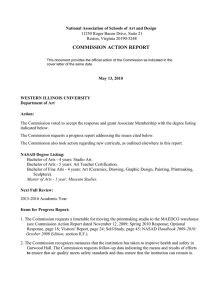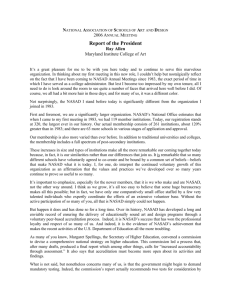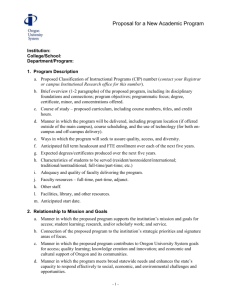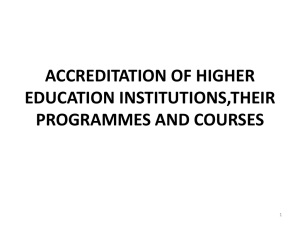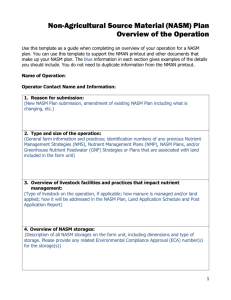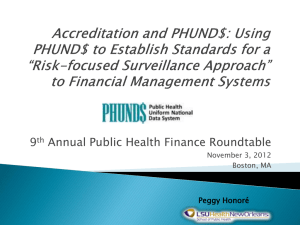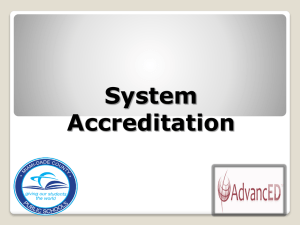MSWord - National Office for Arts Accreditation
advertisement
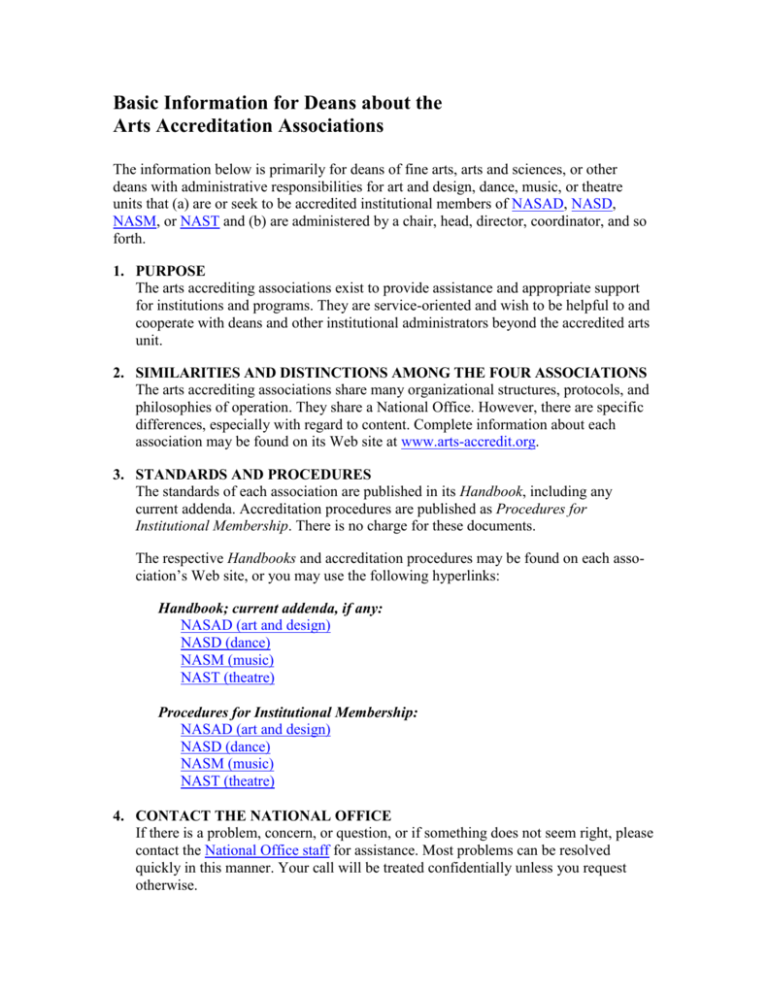
Basic Information for Deans about the Arts Accreditation Associations The information below is primarily for deans of fine arts, arts and sciences, or other deans with administrative responsibilities for art and design, dance, music, or theatre units that (a) are or seek to be accredited institutional members of NASAD, NASD, NASM, or NAST and (b) are administered by a chair, head, director, coordinator, and so forth. 1. PURPOSE The arts accrediting associations exist to provide assistance and appropriate support for institutions and programs. They are service-oriented and wish to be helpful to and cooperate with deans and other institutional administrators beyond the accredited arts unit. 2. SIMILARITIES AND DISTINCTIONS AMONG THE FOUR ASSOCIATIONS The arts accrediting associations share many organizational structures, protocols, and philosophies of operation. They share a National Office. However, there are specific differences, especially with regard to content. Complete information about each association may be found on its Web site at www.arts-accredit.org. 3. STANDARDS AND PROCEDURES The standards of each association are published in its Handbook, including any current addenda. Accreditation procedures are published as Procedures for Institutional Membership. There is no charge for these documents. The respective Handbooks and accreditation procedures may be found on each association’s Web site, or you may use the following hyperlinks: Handbook; current addenda, if any: NASAD (art and design) NASD (dance) NASM (music) NAST (theatre) Procedures for Institutional Membership: NASAD (art and design) NASD (dance) NASM (music) NAST (theatre) 4. CONTACT THE NATIONAL OFFICE If there is a problem, concern, or question, or if something does not seem right, please contact the National Office staff for assistance. Most problems can be resolved quickly in this manner. Your call will be treated confidentially unless you request otherwise. 5. BASIC INFORMATION Information designed for those not familiar with the associations can be found in the section of each Web site titled “Executives New to (NASAD, NASD, NASM, NAST).” The most basic description of how each group works is found in Getting Your Bearings (NASAD, NASD, NASM, NAST). Fundamental philosophical positions are found in A Philosophy for Accreditation in the Arts Disciplines (NASAD, NASD, NASM, NAST) and Code of Good Practice for the Accreditation Work of (NASAD, NASD, NASM, NAST). 6. OFFICIAL REPRESENTATIVES Only institutions hold accredited membership and have a vote. Each institution appoints an official institutional representative to each arts accrediting association of which it is an accredited institutional member. This individual is a delegate on behalf of the institution, not an individual member of the Association. For obvious reasons, institutions normally appoint the executive leader of the accredited unit, but other administrators and faculty are also appointed. For more information about and a set of basic responsibilities for official representatives, including those regarding communication, see “How to Be an Official Institutional Representative to (NASAD, NASD, NASM, NAST).” We strongly urge deans to read this document. An individual does not have to be the official representative to attend meetings and otherwise interact with the work of the association. 7. OFFICIAL ACCREDITATION COMMUNICATIONS As a dean, you, along with the chief executive officer and the chief academic officer, will receive automatically a copy of any Commission Action Report and cover letter, if your name and address are on file with the National Office. You, but not the CEO and CAO, will also receive a copy of notice of excessive lateness in filing an annual report, or HEADS report. Contact information for you, the CEO, and the CAO is requested each year on an accreditation audit form (NASAD, NASD, NASM, NAST) that is sent to the official institutional representative. This contact information may be updated any time by informing the National Office either directly or through the official institutional representative. 8. OTHER MAILINGS As a dean with administrative responsibilities for an arts unit within an accredited institution, you may also receive copies of all mailings sent to the official institutional representative of that unit if this request is indicated on the annual accreditation audit (NASAD, NASD, NASM, NAST) for that unit, or you so request directly to the National Office. Basic Information for Deans: Arts Accreditation CAAA 11/06 – page 2 9. INTERNAL COMMUNICATIONS Beyond the protocols addressed in items 7. and 8. above, matters of security, autonomy, efficiency, and accuracy, internal communications procedures and protocols about specific arts accreditation matters are determined at each institution. Normally, deans will participate in and otherwise influence the development and approval of these procedures and protocols. Arts accreditation matters include, but are not limited to, various aspects of periodic reviews for renewal of Membership, reviews of new curricula between membership reviews, drafts of standards and other documents sent for comment, the annual HEADS report, HEADS special statistical reports commissioned by the institution, and login information giving access to the HEADS data system and the complete Web site of an association. The communication procedures and protocols developed at the institution should describe the levels and types of information various offices or groups want and need to know, when and by whom they are to be informed, and who is to have what access and decision-making responsibilities. Each association has developed a series of worksheets to assist institutions in developing the procedures and protocols that will work for them in the most typical categories of engagement: (1) Membership/renewal of Membership; (2) New Curricula; (3) Standards Reviews and Changes; (4) Higher Education Arts Data Services (HEADS) Project; and (5) Web Site Access. We strongly encourage the kind of planning and decision-making these worksheets facilitate; however, use of the worksheets is not required. These internal communication worksheets may be accessed on the respective Web sites of each association: NASAD (art and design) NASD (dance) NASM (music) NAST (theatre) Thank you for your leadership and interest in arts accreditation. Please advise us whenever we may provide assistance. Basic Information for Deans: Arts Accreditation CAAA 11/06 – page 3
